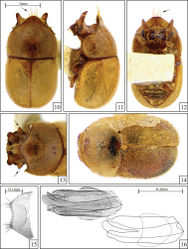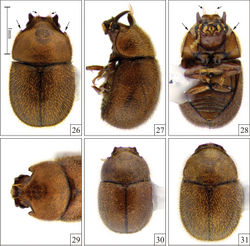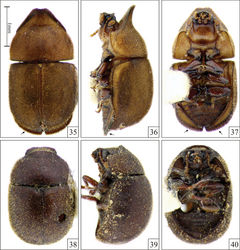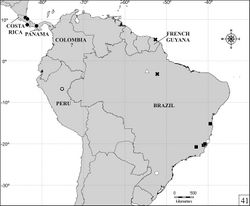| Notice: |
This page is derived from the original publication listed below, whose author(s) should always be credited. Further contributors may edit and improve the content of this page and, consequently, need to be credited as well (see page history). Any assessment of factual correctness requires a careful review of the original article as well as of subsequent contributions.
If you are uncertain whether your planned contribution is correct or not, we suggest that you use the associated discussion page instead of editing the page directly.
This page should be cited as follows (rationale):
Lopes-Andrade C, Lawrence J (2011) Synopsis of Falsocis Pic (Coleoptera, Ciidae), new species, new records and an identification key. ZooKeys 145 : 59–78, doi. Versioned wiki page: 2011-11-04, version 18293, https://species-id.net/w/index.php?title=Falsocis&oldid=18293 , contributors (alphabetical order): Pensoft Publishers.
Citation formats to copy and paste
BibTeX:
@article{Lopes-Andrade2011ZooKeys145,
author = {Lopes-Andrade, Cristiano AND Lawrence, John F.},
journal = {ZooKeys},
publisher = {Pensoft Publishers},
title = {Synopsis of Falsocis Pic (Coleoptera, Ciidae), new species, new records and an identification key},
year = {2011},
volume = {145},
issue = {},
pages = {59--78},
doi = {10.3897/zookeys.145.1895},
url = {http://www.pensoft.net/journals/zookeys/article/1895/abstract},
note = {Versioned wiki page: 2011-11-04, version 18293, https://species-id.net/w/index.php?title=Falsocis&oldid=18293 , contributors (alphabetical order): Pensoft Publishers.}
}
RIS/ Endnote:
Wikipedia/ Citizendium:
See also the citation download page at the journal. |
Taxonavigation
Ordo: Coleoptera
Familia: Ciidae
Name
Falsocis Lopes-Andrade & Lawrence, 2011 sp. – Wikispecies link – Pensoft Profile
Record
1 female (MNHN) Peru: \Mission de Sarayacu (Riv. Oucayale) [Ucayali] [handwritten in green paper] \ CO 47 [handwritten in a circular yellowish paper] \ MUSEUM PARIS PÉROU PAMPAS [sic] DEL SACRAMENTO DE CASTELNAU 1847 [written in light brown paper] \ [circular blue paper, without information]\.
Comments and comparative notes
The specimen was collected at Sarayacu Mission (6°47'S, 75°07'W, Fig. 41) during the French Scientific Expedition to the Pampa del Sacramento, Peru, in 1847. It resembles females of Falsocis brasiliensis, Falsocis egregius sp. n. and Falsocis occultus sp. n. in having the epipleura narrow posteriorly. However, the shallow punctation of pronotum resembles mostly that of the former two species. Female Falsocis brasiliensis from Jussari (Brazil) are similar in color, but body is more elongate. It is very large, with a length of near 3mm. Only females of Falsocis occultus sp. n. reach such a length. A subquadrate body is also observed in a few Falsocis brasiliensis, but the largest females of this species are only 2.4mm long. The very transverse pronotum, twice as long as wide, does not occur in any other known Falsocis species. This female from Peru possibly belongs to another new species, but description is not possible without examining a male. Measurements (in mm) and ratios are as follows: TL 3.05; PL 1.00; PW 2.00; EL 2.00; EW 2.11; GD 1.68; PL/PW 0.50; EL/EW 0.95; EL/PL 2.00; GD/EW 0.80; TL/EW 1.45. Identification key to the species of Falsocis Pic
Taxon Treatment
- Lopes-Andrade, C; Lawrence, J; 2011: Synopsis of Falsocis Pic (Coleoptera, Ciidae), new species, new records and an identification key ZooKeys, 145: 59-78. doi
Images
| Figures 10–16. Falsocis egregius Lopes-Andrade & Lawrence, sp. n., male holotype 10–13 and female paratype 14 shown in the same scale, and slide preparation of male terminalia of a paratype 15–16. 10 Dorsal view (pronotal tuft of long setae, arrow) 11 Lateral view 12 Ventral view (pronotal tuft of long setae, arrow) 13 Head and pronotum view from above (triangular plate behind eyes, arrows) 14 Female 15 Eighth sternite 16 Aedeagus (left) and gross outline of aedeagus (right) showing tegmen (continuous line), penis (dashed line) and basal piece (dotted line). |
| Figures 17–22. Falsocis occultus Lopes-Andrade & Lawrence, sp. n., male holotype 17–19 and female paratype 20 shown in the same scale, and slide preparation of male terminalia of a paratype 21–22. 17 Dorsal view 18 Lateral view 19 Ventral view (acute pronotal apex, arrow) 20 Dorsal view 21 Eighth sternite 22 Aedeagus (left) and gross outline of aedeagus (right) showing tegmen (continuous line), penis (dashed line) and basal piece (dotted line). |
| Figures 26–31. Falsocis brasiliensis Lopes-Andrade, 2007, specimens from Viçosa (in the state of Minas Gerais, southeastern Brazil), all shown in the same scale. 26 Dorsal view (produced angles, large arrows; two tufts of long setae, small arrows) 27 Lateral view 28 Ventral view (produced angles, large arrows; two tufts of long setae, small arrows) 29 Head and pronotum view from above 30 Low male 31 Female. |
| Figures 32–34. Falsocis brasiliensis Lopes-Andrade, 2007, dorsal view, shown in the same scale. 32 The unique female specimen from Santa Maria de Jetibá, in the state of Espírito Santo, southeastern Brazil 33 Male paratype from Venda Nova do Imigrante, Espírito Santo (two tufts of long setae, arrows) 34 Male paratype from Jussari (in the state of Bahia). |
| Figures 35–40. Falsocis opacus Pic, 1916, from Altamira, in the state of Pará, northern Brazil 35–37; arrows pointing out the explanate outer apical margins of epipleura and Falsocis sp., female from Peru 38–40, all shown in the same scale. 35, 38 Dorsal view 36, 39 Lateral view 37, 40 Ventral view. |
|





